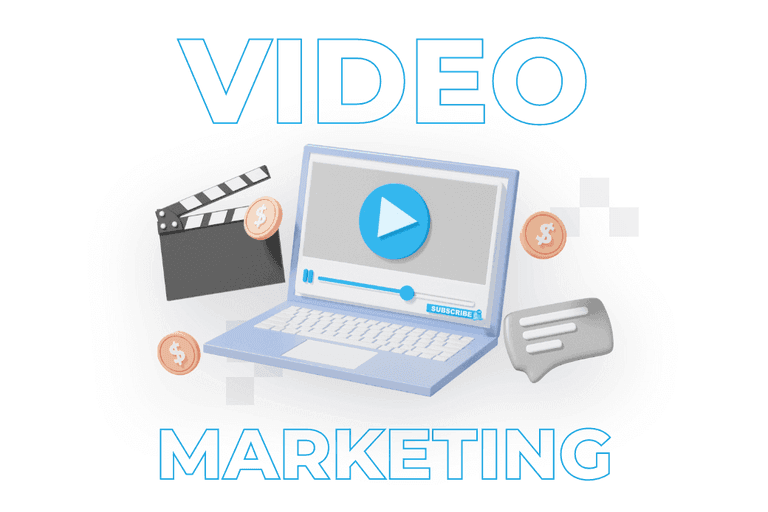Table of contents
- What is video marketing?
- Growing popularity of video marketing
- Types of video marketing
- What are the benefits of video marketing?
- How to implement video marketing in your operations?
- Video marketing on social media
- The role of video marketing in SEO and SEM
- Video marketing vs. content marketing
- Video marketing – your key to success

Video marketing – how can videos promote your brand?

In a popular song by the band The Buggles, it could be heard that ‘video killed the radio star’. There is no denying that videos (and images more broadly) have had a very strong influence on marketing for years, and the proliferation of the internet and mobile devices has led to an increase in their importance. What is video marketing and how can it impact your business?
What is video marketing?
Video marketing is a branch of visual marketing that uses audiovisual materials such as films, animations and presentations. Due to its interactivity and ability to engage audiences on an emotional level, it is an increasingly popular advertising medium in the digital world. Regardless of the industry or size of the company, different types of video can be used to achieve marketing objectives such as building brand awareness, increasing consumer loyalty or generating conversions.
Growing popularity of video marketing
Video marketing is becoming an increasingly popular tool in the advertising strategies of companies around the world. Introducing video into a marketing strategy can bring tangible benefits such as increasing brand awareness, building a strong reputation or improving customer relationships. Here are some of the key drivers behind the growing importance of video marketing:
- Changing consumer behaviour – in the age of ubiquitous internet access, more and more people are using smartphones, tablets or computers. The proliferation of image-centric digital media means that consumers are reaching for video content more often and their appetite for this type of content is growing.
- Thehighly engaging power of video – even in its early years, cinema showed that it could be highly engaging. Videos have the ability to capture the audience’s attention and hold it for longer than text or images. With its dynamism and ability to convey information on multiple levels, video engages audiences on emotional, intellectual and sensory levels.
- Developments in technology – increasingly cheaper and more advanced video technologies are making video production cheaper and more accessible. In addition, artificial intelligence or augmented reality are introducing new possibilities for the creation and distribution of video content.
- Effectiveness in meeting marketing objectives – video helps meet objectives such as building brand awareness, generating leads or increasing conversions.
- Social media algorithm preferences – Facebook, Instagram or YouTube promote video content because it increases user engagement. For this reason, video marketing can improve your brand’s visibility and reach on social media.
- Ease of consumption – being able to convey complex information in an accessible and attractive way makes it easier for audiences to absorb content.
Types of video marketing
As with film, there are different types of video marketing. They serve different purposes and support different marketing activities, so choosing the right format should be tailored to your company’s capabilities, goals and budget.
The first type is promotional videos – they focus on introducing products or services and convincing customers to buy them. They are designed to grab customers’ attention with attractive visual effects and creative scripts. Often their script is written in the language of benefits, with images showing key information about your product and what the recipient can gain from it. Their authors use storytelling to tell an interesting story about a product, brand, event or service.
Educational videos are another type. Their purpose is to educate customers on how to use a product or perform a specific task. They are nothing more than an audiovisual instruction manual. They make it easier for viewers to understand the application of the proposed solutions, which can lead to a better experience with the brand. These types of videos can help promote your brand as a source of interesting content (even a simple action can be presented in an interesting way) and have an impact on website positioning.
Another type is videos presenting the opinions and experiences of real customers. They can increase trust in the brand and its credibility in the eyes of potential customers. Creating recommendations often involves working with industry experts or influencers.
It is also worth mentioning webinars, which allow you to interact with your audience in real time, providing them with valuable content and addressing their concerns in real time. Webinars are a particular example of live broadcasting, which is also part of video marketing. Events such as conferences, lectures or sporting events are most often broadcast live. They promote interaction with viewers and can increase viewership.
Corporate videos depict mission, vision and values of the company, its culture and goals. They can be used in employer branding to create a brand image and build relationships with customers, business partners or potential employees.
Video marketing can be divided not only by genre, but also by production technology. Here, it is worth mentioning 360-degree videos, which give the viewer the ability to freely ‘move’ in the space in which the video is presented. It provides a more realistic and immersive experience. They can be used in the tourism industry or in real estate to show interiors.
On the other hand, films using drones present a place, products or services from an unusual perspective, which can engage viewers and increase interest in the offer. Finally, animated films can be used for educational and promotional purposes. Thanks to their creativity and originality, animations attract the attention of different audiences while communicating key information in an accessible way.
What are the benefits of video marketing?
Video marketing, due to its dynamic nature and ability to engage audiences, brings a number of benefits to businesses, both tangible and intangible. These include:
Increased brand recognition
Video can effectively build brand awareness because it allows the values and personality of a company to be conveyed in an appealing and emotional way. The more viewers identify with the message, the more likely they are to recommend the brand to others. Coca-Cola’s Christmas adverts are a case in point.
Increasing conversions
Videos can ‘convince’ customers to buy products or services. This translates into increased sales and revenue. Websites containing video content have higher conversion rates than those based solely on text.
Building trust
Instructional or customer feedback videos help to build brand trust and credibility. They can show that a company cares about the needs of its audience and strives to solve their problems, which increases the chance of maintaining a long-term relationship.
Increasing customer engagement
Video encourages interaction with the audience – comments, shares or likes. This leads to an increase in content reach and brand visibility on social media and search engines. To increase audience engagement, it makes sense to partner with influencers.
Facilitating the communication of information
Videos make it possible to communicate complex concepts in an accessible and understandable way. This is particularly important for products or services with a high level of complexity.
Standing out from the competition
Original videos can make a brand stand out in the market, attracting customers’ attention and building a positive corporate image. They can also form an important part of your brand’s content marketing efforts.
How to implement video marketing in your operations?
Implementing video marketing in your company’s operations may seem complicated, but it is as achievable as possible. Start by defining the goal you want to achieve. This could be to increase brand awareness or conversions, educate customers or promote new products.
Next, define your target audience, which defining your sales persona can help with. Understanding the needs, preferences and expectations of your model customers is key to creating engaging and effective video content. To do this, it is worth conducting market research and competitor analysis.
The next step is to design a video marketing strategy. It should specify the types of video content you intend to create, distribution channels, publication schedule, budget and relevant metrics to measure the effectiveness of your efforts. It should be tailored to your objective, target audience and in line with your overall marketing strategy.
Remember that your content should align with your brand values and deliver value to your audience. This doesn’t change the fact that it’ s worth experimenting with different types of video – don’t limit yourself to one type of video. Experiment with formats such as commercials, explainer videos, webinars, interviews or animations. A variety of content will give you a better understanding of what will attract the most attention and engage your target audience.
Don’t forget that videos need to be adapted to the requirements and specificities of each distribution channel – social media, website or streaming platforms. It is also worth ensuring regularity of publication. This is important for building a loyal audience base and keeping them engaged. Maintain consistency both in terms of your publication schedule and the quality and style of your material.
Encourage audience interaction in your content , such as leaving a comment, liking, sharing or subscribing. Interactions increase audience engagement and improve the visibility and reach of your videos.
When it comes to videos, don’t forget about SEO. Make sure they are optimised for search engines to increase their visibility and reach. Use relevant keywords, titles, descriptions and thumbnails.
Once implemented, continuously track the various – number of views, engagement, conversions or time spent watching videos. They allow you to assess the effectiveness of your actions and allow you to quickly optimise if necessary. Stay on top of trends, analyse the results of your actions and adapt your strategy to achieve better results and meet your audience’s expectations.
If you don’t have the resources in-house, consider working with an advertising agency, freelancers or other video marketing specialists. Experts can help you develop a strategy, produce quality content and optimise and distribute your content.
Video marketing on social media
provide the perfect environment for distributing and promoting video content. Videos on social media allow you to reach a wide audience, increase engagement and build relationships.
Platforms on which video marketing activities can be applied include:
- Facebook – allows you to publish and promote a variety of video content, such as background videos, Facebook Live, or videos in the ‘Watch’ section.
- Instagram – within it, you can publish short videos, Instagram Stories, Reels and live broadcasts via Instagram Live.
- YouTube – the most popular platform for publishing and sharing videos, offering the ability to create your own channels and use a variety of video ad formats.
- – a professional social platform where you can publish videos focused on education, industry information or professional development.
- – a rapidly growing platform based on short, engaging videos, offering a range of tools for creative video editing and editing.
- – allows you to publish short, shareable videos that can be commented on to gain greater reach and engagement.
It is important to remember that each sitehas its own characteristics, so videos should be tailored to the requirements and expectations of the users of each site.
Various genres of videos can be used on social media, but it is important to remember that they should not be long. Many people are unable to hold their attention for long periods of time, so it is advisable to focus on forms that last from several seconds to around three minutes. The most commonly used forms of social media videos are:
- video ads,
- instructional videos,
- educational videos,
- webinars and live broadcasts,
- testimonials (opinion videos),
- ‘behind the scenes’ videos.
Using a video on social media increases the chances of the content spreading widely, leading to an increased audience and brand recognition. They also allow you to show an authentic side of your company, which can build trust and greater audience engagement. They can also effectively encourage audiences to purchase products or services, resulting in increased conversions and revenue.
The role of video marketing in SEO and SEM
Video marketing plays a significant role in strategies . Videos can help improve a website’s SEO, increase traffic and conversions.
For SEO, videos engage users and encourage them to stay on the site longer, which is an important factor considered by search engines when assessing the quality of a site. In addition to this, they can capture visitors’ attention, reducing the likelihood of them leaving the site quickly, which also has a positive impact on SEO.
Attractive video content can generate more links to your website, which improves the page’s position in search results. Various videos are important elements of the Google SERP. It is increasingly displaying video content in search results, which increases visibility and the chances of attracting users.
As part of SEM activities, video ads are often used as a form of paid promotion on search engines and platforms such as YouTube. They can increase reach, engagement and conversion, which translates into higher . They can also generate a higher CTR, as they attract users’ attention and encourage them to click on the ad. They also work well for remarketing.
To achieve this, however, do not forget to optimise your video content by adding relevant keywords, descriptions, transcripts and titles. This will make it easier for search engines to understand the video content and improve indexing.
It is also worth remembering that users are increasingly viewing videos on mobile devices, so it is important that they are optimised for loading speed and viewing quality on smaller screens. They should also be accessible to the widest possible audience, taking into account, for example, subtitles or transcriptions for the deaf.
Video marketing vs. content marketing
Videos are important elements of . They are one of the main and most attention-grabbing types of content. Video is able to capture users’ attention, convey emotions and complex information in a way that is easy to digest. It is also more likely to be shared on social media and other platforms, allowing it to reach a wider audience and increase brand recognition.
Video marketing can work in tandem with other forms of content marketing, such as blogs, infographics or e-books, by enriching content with videos that further explain or illustrate the topics covered. It can also be used to build authority and trust. Webinars or interviews with experts help build a company’s authority in a particular industry, which translates into greater trust from the audience.
Videos can help to attract new customers by demonstrating the added value of products or services and to retain existing customers by offering valuable content that meets their needs and interests. They can also support the sales process at various stages, from initial interest to the purchase decision.
Video marketing – your key to success
Video marketing is an essential part of today’s marketing strategies. Not only is video an attractive form of communication, but it is also an excellent tool for content marketing, SEO, SEM and social media promotion.
However, video marketing can face some limitations, such as higher production costs or the need to adapt to different platforms and audiences. There is also a risk of information overload – audiences are exposed to a huge amount of video content every day, which can make it difficult for your brand to stand out.
However, despite the potential limitations, video marketing offers significant benefits for organisations – these include increased brand awareness, higher conversions or interest in products or services. For this reason, your company should consider investing in different types of videos to improve its market potential and achieve success in the marketplace.
Contact form
Develop your brand
Rate content:
You may be interested in:




